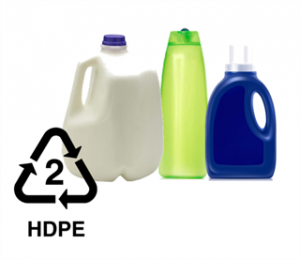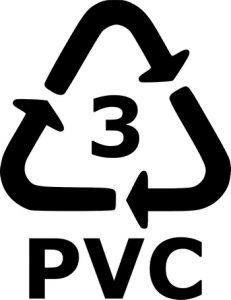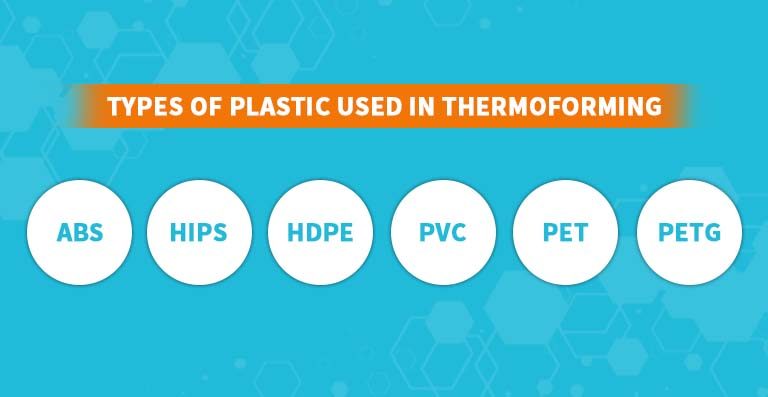6 Different Plastics that Lead the Way for Thermoforming
Thermoforming is a plastic molding method that is used to create a variety of usable products. The manufacturing process involves heating of thin plastic sheets to make them pliable. Once the sheet reaches a malleable temperature, it is materialized over a male or female mold. It is then cooled to a finished shape and the product is trimmed to make it usable. A variety of plastics are used for thermoforming, however, in this blog, we are focusing on six types of plastic that lead the way for thermoforming.
1) ABS
ABS is a common thermoformed plastic that is made of acrylonitrile, butadiene, and styrene. It can withstand extreme temperatures ranging from -4 to 176 °F. This ensures that the plastic can be molded to any desired shape at high temperatures. ABS is corrosion resistant and impact proof. This makes it an ideal polymer for 3D printing, automobile parts, protective headgear, and kitchen appliances.

2) HIPS
HIPS or high impact polystyrene is a versatile plastic that is used to make a variety of consumer products. Its clear composure makes it an ideal choice for protective food packaging. It boasts high impact resistance and has high tensile strength. What makes HIPS a desirable plastic for thermoforming is its ability to be malleable. It can be molded to different shapes multiple times and it can still preserve its properties.

3) HDPE
High-density polyethylene or HDPE is a petroleum-based thermoplastic polymer and is known for its excellent strength to density ratio. HDPE is used in numerous applications such as bottle, plastic packaging, 3D printing, and plastic bags. HDPE is UV resistant and chemical resistant. This makes a great choice to create thermoformed plastic products such as shampoo bottles, food trays, containers, and recycle bins.

4) PVC

PVC or polyvinyl chloride is the third most-used plastic for thermoforming. It is created with suspension polymerization and has a tough structure making it an ideal plastic to withstand impacts and extreme temperatures. What’s more, it is an economical plastic which makes it a preferred material of choice for most industries. PVC is commonly thermoformed to create products such as pipes, flooring, electric cables, and faux leather clothing.
5) PET
PET or polyethylene terephthalate is one of the most common plastics used for thermoforming. It is used to produce bottles and synthetic fibers. During thermoforming, PET is molded into a product shape and later dried to maximize its resistance. Thermoformed products made from PET are resistant to external elements such as weather and corrosion.

6) PETG
Polyethylene terephthalate glycol or PET-G is a type of thermoplastic polyester that is easily formable. It is known for its durability, resistance to chemicals and is ease of manufacture. What’s more, PET-G is a low forming temperature polymer. This allows it to be easily vacuumed and pressure-formed to create end-products of various shapes. It is also ideal for fabrication methods such as routing, bending and cutting.

If you are in the thermoforming industry, then Plastivision is a great platform for you to showcase your product range and network with industry professionals. Book your booth today!
Leave a Reply Cancel reply
Recent Posts
- Understanding The Materials That Are Used To Build Plastic Toys
- All You Need To Know About Food-grade Plastics
- A Glance At The Materials That Boost The Performance Of Plastics
- Understanding The Importance Of Exploring New Business Opportunities In The Plastic Industry
- Understanding The Importance Of Investing in R&D For The Plastic Industry
Categories
- 3D Printing
- AIPMA
- Automation
- Automobile Sector
- Bio Plastics
- Environment
- Innovations In Recycling
- Latest Innovations
- Molds & Dies
- News
- Packaging Industry
- Plastic
- Plastic Application
- Plastic Industry
- Plastic Market
- Plastic Myths
- Plastic News From The World
- Plastic Packaging
- Plastic Products
- Plastic Recycling
- Plastic Solar Cells
- Plastic Toys
- Plastic Waste
- Plastic World
- Plastics
- Plastics And Their Applications
- Plastics In Agriculture
- Plastics In Healthcare
- Plastics In Medical Industry
- Plasticulture
- Processing Machinery
- Recycling Machines
- Robotics
- Uncategorized
- Virtual Reality
Archives
- November 2023 (3)
- October 2023 (2)
- September 2023 (3)
- August 2023 (3)
- July 2023 (3)
- June 2023 (3)
- May 2023 (2)
- April 2023 (2)
- March 2023 (2)
- February 2023 (2)
- January 2023 (2)
- December 2022 (3)
- November 2022 (1)
- October 2022 (1)
- September 2022 (2)
- August 2022 (1)
- July 2022 (3)
- May 2022 (3)
- March 2022 (2)
- February 2022 (1)
- January 2022 (1)
- September 2021 (2)
- August 2021 (3)
- July 2021 (4)
- June 2021 (4)
- May 2021 (3)
- April 2021 (2)
- March 2021 (4)
- November 2019 (8)
- October 2019 (8)
- September 2019 (8)
- August 2019 (8)
- July 2019 (8)
- June 2019 (8)
- May 2019 (8)
- April 2019 (8)
- March 2019 (8)
- February 2019 (11)
- January 2019 (8)
- December 2018 (8)
- November 2018 (12)
- October 2018 (12)

